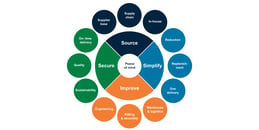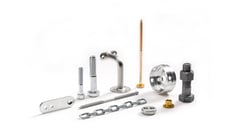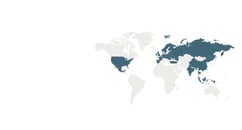- Insights
- The Solutionists Hub
- What is the Total Cost of Ownership in C-Parts Purchasing?
What is the Total Cost of Ownership in C-Parts Purchasing?

If you’re a C-parts purchaser in a manufacturing company trying to get the best possible value for money, the term ‘total cost of ownership’ (TCO) needs to be at the front of your mind.
In a purchasing role, it’s natural to search high and low for the best price. Certain suppliers may be able to offer different unit prices or discounts, and by choosing the right one and succeeding in your negotiations, it’s often possible to find a good deal.
There’s nothing wrong with looking for a good price, but when it comes to C-parts, you’ll struggle to make really significant savings by optimising only on the purchase price, since by definition, C-parts are the least-expensive components used in your production.
The price of the C-parts themselves is the direct cost. However, when it comes to the total cost of C-parts, this direct cost typically makes up only 20%. The remaining 80% is made up entirely of indirect costs – all the costs associated with ordering, negotiating, handling, troubleshooting, replenishing, quality assurance, controlling your inventory and developing a relationship with the supplier.
So if you’re looking to save money, these are the costs you should be focusing on. Not only is it easier to make large reductions in these costs, the financial benefits will also be felt throughout your organisation.
If you’re a C-parts purchaser looking to use your budget as efficiently and effectively as possible, focusing on TCO and not just price is essential. It’s true that succeeding in bringing down your TCO can be a trickier and more long-term project than just getting a good deal on a shipment of C-parts – but the effects are worth it.
The true cost of C-parts
By far the most impactful step you can take to reduce your TCO is to consolidate your C-parts supplier base. Most of the heaviest indirect costs – around things like administration, negotiation and receiving, handling deliveries and securing quality – can become a major burden if you have to deal with too many suppliers. That’s because a simple task like paying an invoice or placing an order can become very time-consuming when you have to repeat it for every supplier you deal with on a regular basis.
These kinds of tasks might not seem very important, but they add up over time. In my experience, the average indirect cost of a single supplier for a typical manufacturing company is somewhere in the range of €6,000 to €10,000 per year – and that’s on top of the price you pay them for the C-parts.
A purchaser who only focuses on price would be likely to choose a supplier based on a 15% improvement in the purchase price of an order of C-parts. However, with yearly supplier costs like this, that purchaser could make even bigger savings by consolidating and sourcing their C-parts from a smaller number of suppliers.
With fewer suppliers, there’s less repeated work – and a stronger partnership with the preferred suppliers can be achieved.
What factors contribute to TCO?
I mentioned the basic building blocks of the total indirect cost above, but I think it’s worth going into more detail here.
The total cost of ownership is made up of the direct cost (the price you pay for your C-parts) and a wide range of indirect costs, such as:
- Management – The cost of sourcing the right suppliers, as well as auditing your existing suppliers
- Administration – Costs related to making orders, checking order confirmations, paying invoices (and managing invoices that are incorrect) and all other costs around expediting
- Logistics – The costs that come with arranging urgent deliveries, transporting empty boxes back to the suppliers, potential re-packing costs and receiving many small deliveries from numerous suppliers (for companies with an unconsolidated supplier base).
- Operation – The cost of handling the goods at your facility, picking the right C-parts for the production line, managing inventory and replenishment, kitting, troubleshooting when issues arise, and the very significant costs of downtime and other production disturbances caused by a lack of C-parts
- Warehousing – The cost of storage and the capital costs of your inventory, as well as obsolescence costs
- Quality – The cost of controlling and developing the quality you receive from suppliers
These individual indirect costs can vary across different companies. For example, if your C-parts inventory is fairly small, storage costs are probably a minor post in your TCO. However, if high MOQs have forced you purchase a large quantity of C-parts all at once, storage costs can easily rise.
How to measure these costs
In my experience, even large companies with lots of resources at their disposal often struggle to gain an understanding of what all these indirect costs add up to. The needed information about these different costs is usually spread across the company, and most team members are typically too busy to spend time on a large-scale analysis like this.
For that reason, you generally get the best results by bringing in a supply chain partner. They can use their knowledge of C-parts supply chains to do this analysis for you – which is a crucial first step in making the changes that will actually reduce your TCO.
How to reduce your costs
As you’ve seen, the list of indirect costs is long, so there’s lots of measures you can take to reduce them. However, these actions are the most effective:
- Consolidate your supplier base – Source and purchase the parts you need from a smaller pool of suppliers, either only a few or maybe even just one
- Consolidate the number of articles you need – By taking the C-parts supply chain into account during the product design phase, you can reduce the number of parts you need to buy to manufacture your products.
- Invest in digital solutions – There’s a range of digital tools available from different suppliers that make your ordering, replenishment and administration side of things much smoother and simpler. Solutions like these enable real-time inventory updates and automatic ordering, which reduces the risk of parts shortages or downtime caused by human error.
A good supply chain partner can help you with all of these things and work to bring your TCO down. By transferring your C-parts needs to them, you suddenly have only one supplier to deal with, not several. And by creating a KPI that focuses on TCO together with the supplier, you can follow up on a regular basis and track your progress. Extra benefits such as consolidated deliveries and solutions in logistics and VMI can reduce the TCO even further – in our experience, you can expect this process to bring cost reductions of 15-20%.
However, this process takes effort, and it might be more tempting to try to negotiate with your existing suppliers for a similar reduction in price. However, when reducing your indirect costs, you’ll experience this saving every day – and in time, it’ll add up to large sums.
If you’re interested in finding out how Bufab can help you in this area, make sure to get in touch with one of our experts. You can also take a look at our in-depth guide to C-parts purchasing for more insights on different aspects of purchasing, and if this article was interesting, you’d also like ‘The C-Parts Purchaser’s Guide to Supplier Consolidation’ – available to download below.
Get new knowledge every week!
Related
-
By Jonas CaseliusHow Does the C-Parts Supplier Consolidation Process Work in Practice?
-
By Maria GötessonCommon C-Parts Purchasing KPIs, and How to Improve Them
-
By Oskar SvenssonVendor Managed Inventory: The Benefits of VMI for C-Parts Purchasers
-
By Tuomo TiainenMy Tips for How to Succeed as a C-Parts Purchaser
-
By Carina LööfSustainable Purchasing: Guidance for C-Parts Purchasers
-
By Slawomir BieszkHow to Source C-Parts: Tips for Purchasers
-
By Slawomir BieszkMOQ: How to Deal With High Minimum Order Quantity for C-Parts










